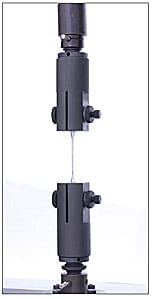Pin Grips for Flat Specimens

Features:
- Designed for tensile testing of hard metal plates that are difficult to grip using more common grips
- Models with maximum capacity up of 10 kN (4,400 lbf), 50 kN (11,000 lbf), and 100 kN (22,000 lbf)
- Specimens are held within the grips by passing pins through holes in the specimens
- Includes adjustment screws, or bushes, that center different thickness specimens
Relevant Materials:
Metals, Ceramics
Relevant Specimens:
Plates
Pin grips are very user friendly and are designed for conducting tensile tests of hard metal plate specimens that are difficult to grip. Specimens are held within the grips by passing pins through holes in the specimens.
A beneficial feature of these grips is different specimen thicknesses can be accommodated because of the incorporation of specimen thickness adjustment screws, or bushes, which position the specimen at the center of the grips.
News / Events
-
AUTOGRAGH AGS-X2 Series has been released
The Shimadzu AUTOGRAPH AGS-X2 series provides superior performance and practical testing solutions for a wide array of applications. Offering high-level control and intuitive operation, the AGS-X2 series sets a new standard for strength evaluations while providing the utmost in safety considerations in a modern, stylish design.
-
AUTOGRAGH AGS-V Series has been released
Shimadzu Corporation released the Autograph AGS-V Series precision universal testing machine. In this series, the range over which the force measurement accuracy is guaranteed has been increased by a factor of two compared with existing machines. As a result of this new function, the work required to change force measurement sensors and accessories required for measurement can be reduced.
-
High-Speed Video Camera HyperVision HPV-X3 has been released
Recording speed of 20 million frames/second, the highest in its class provides larger, clearer, high-sensitivity recording. HPV-X3 is equipped with a synchronized recording function and high-level analytical capabilities that accommodate a variety of software programs.
-
New Video: AUTOGRAPH AGX-V2 Voice Operation Device XV-Talk
We will introduce how XV-Talk, the world's first voice control device installed in Shimadzu's latest tensile tester AGX-V2, can be used in various scenarios.
-
New Video: AUTOGRAPH AGX-V2 Operation Control Panel Stand-alone test feature
We will introduce a new feature of Shimadzu's latest tensile tester, AGX-V2, a stand-alone testing function using a large color LCD touch panel.
-
New Autograph AGX-V2 Series Precision Universal Testing Machines
The World’s First Testing Machines Equipped with a Voice Operation Device


